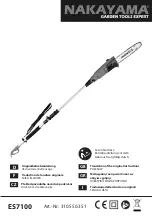
7
Cutting Angled Materials
When cutting angle materials, tilt the tool back to
avoid having the lower guard rest on the angle.
Correct Technique
I
ncorrect Technique
Cutting Thin or Corrugated Materials
Cut thin and corrugated materials at least 1" from the
edge of the workpiece to avoid injury or damage to
the tool caused by thin strips of metal being pulled
into the upper guard.
Cutting Large Sheets
Large sheets sag or bend if they are not correctly
supported. If you attempt to cut without leveling and
properly supporting the workpiece, the blade will tend
to bind, causing KICKBACK
.
Support large sheets. Be sure to set the depth of the
cut so that you only cut through the workpiece, not
through the supports.
When cutting widths greater than 4", clamp or tack
1" lumber to workpiece and use the inside edge of
the shoe as a guide.
WARNING
To reduce the risk of electric shock,
check work area for hidden pipes
and wires before making pocket cuts.
Pocket Cutting
Pocket cuts are made in the middle of the workpiece
when it can not be cut from an edge. We recommend
using a Sawzall
®
reciprocating saw or jig saw for this
type of cut. However, if you must use a circular saw
to make a pocket cut, USE EXTREME CAUTION.
To maintain control of the saw during pocket cutting,
keep both hands on the saw.
1. Beginning at a corner, line up the sight line with
your cutting line. Tilt the saw forward, firmly fixing
the front of the shoe on the workpiece. The blade
should be just above cutting line, but not touching it.
Raise the lower guard using the lower guard lever.
2. To start the saw, push the lock-off button down
while pulling the trigger. Allow the motor to reach
full speed before beginning cut. Using the front
of the shoe as a hinge point, gradually lower the
back end of the saw into the workpiece. Release
the lower guard lever and grasp the front handle.
3. When the shoe rests flat against workpiece,
advance the saw to the far corner. Release the
trigger and allow the blade to come to a complete
stop before removing it from workpiece. Repeat the
above steps for each side of the opening. Use a
Sawzall
®
reciprocating saw, jig saw or small hand
saw to finish the corners if they are not completely
cut through.
MAINTENANCE
WARNING
To reduce the risk of injury, always
unplug the charger and remove the
battery pack from the charger or tool before
performing any maintenance. Never disassemble
the tool, battery pack or charger. Contact a
MILWAUKEE service facility for ALL repairs.
Maintaining Tool
Keep your tool, battery pack and charger in good
repair by adopting a regular maintenance program.
Inspect your tool for issues such as undue noise,
misalignment or binding of moving parts, breakage of
parts, or any other condition that may affect the tool
operation. Return the tool, battery pack, and charger
to a MILWAUKEE service facility for repair. After six
months to one year, depending on use, return the
tool, battery pack and charger to a MILWAUKEE
service facility for inspection.
If the tool does not start or operate at full power with
a fully charged battery pack, clean the contacts on
the battery pack. If the tool still does not work prop
-
erly, return the tool, charger and battery pack, to a
MILWAUKEE service facility for repairs.
WARNING
To reduce the risk of personal in-
jury and damage, never immerse
your tool, battery pack or charger in liquid or
allow a liquid to flow inside them.








































